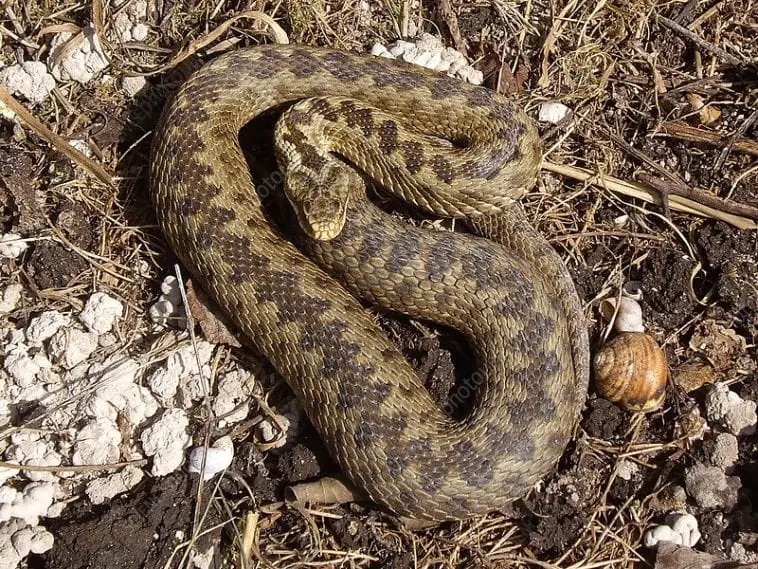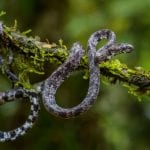The term “viper” refers to any of 200+ species of venomous snakes that are classified into two groups: the pit vipers or the Old World Vipers. Vipers prey on small animals and look for food by hunting, striking and biting their prey.
This family of snakes has long, hollow fangs that are attached to bones of the upper jaw. The fangs are folded back from inside their mouth when unused. Vipers are among the most popular and the most feared snakes in the world. Here are eight true viper species worth mentioning.
1) Common European adder (Vipera berus)
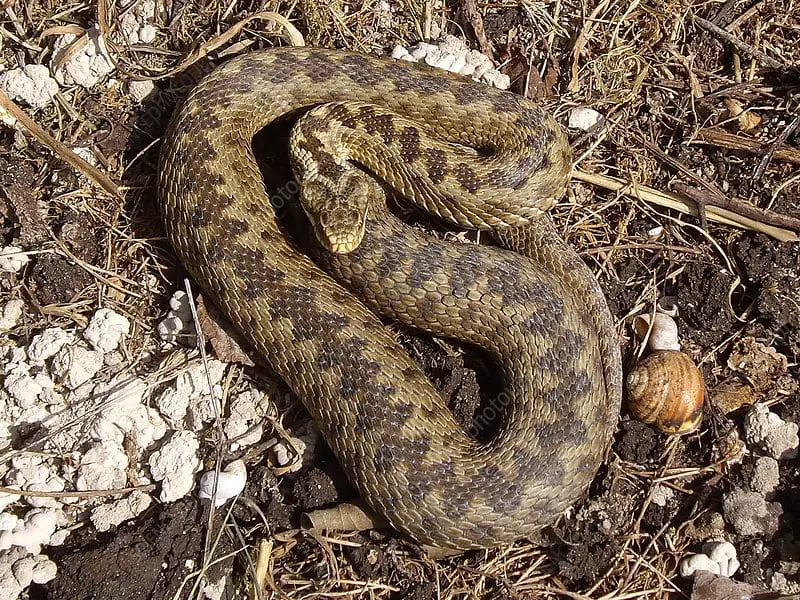
The common European adder is a venomous snake that’s native to many parts of Western Europe and East Asia. This viper is also called common viper or common adder and is not really known to be dangerous and usually bites when provoked, picked up, or accidentally stepped on. The bite of a common European adder is painful but is not fatal.
The common European adder is found in many different terrains, and it eats small mammals, lizards, amphibians, and birds. This snake has a thick body with adults growing up to 24 inches in length including the tail. The largest common European adder is 35 inches and was seen in Scandinavia.
The head of the common European adder is large and very distinct, with the sides looking vertical and flat. It has large eyes that are equal in size or larger than of its nasal scale. The middle body has dorsal scales and is loosely attached to its skin with the lower rows wider.
The color of the common European adder ranges from light to very dark or brown. There are faint to clear darker marks all over the body, and most specimens come with zigzag dorsal marks along the entire length of the body and tail.
The common European adder’s head has a distinct V or X on its back, and a dark pattern runs along with the eyes to the neck to the flanks. Males may be distinguished from females from their colors. Females come with brownish hues with dark-brown patterns. Meanwhile, males come in pure gray with black patterns. The zigzag pattern stands out in males.
Common European adders are not aggressive and are rather timid. When people are nearby, adders will simply disappear to the bushes or undergrowth. It will return to the area once it is quiet. When it is threatened, the front part of its body becomes an S-shape so that it can quickly strike.
Common European adders can adapt to the cold and will hibernate during the winter. These snakes will hibernate from 150 to 180 days.
2) Gaboon viper (Bitis gabonica)
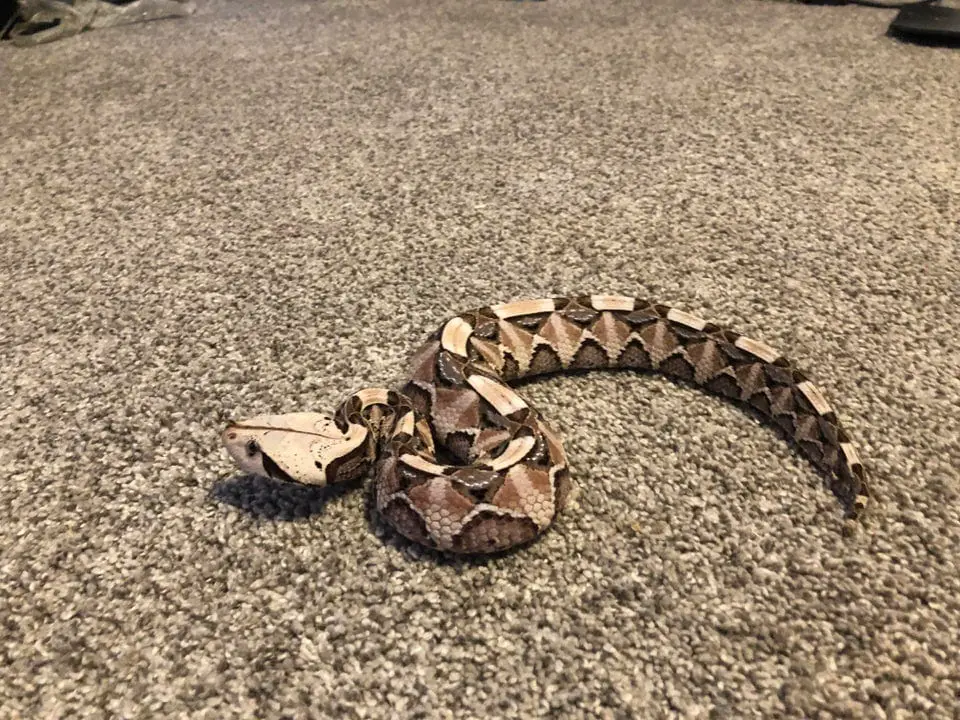
Gaboon vipers or Gabon vipers are extremely dangerous but are mostly docile snakes. This viper is found in tropical areas of western and central Africa. It is one of the heaviest snakes in the continent, which can weigh up to 18 pounds and can grow up to 7 feet long.
Gabon vipers also have the longest fangs, which measure up to 1.6 inches long. It has a large body with rectangle and triangle patterns that are purple, brown or buff. These marks create a velvety smooth appearance and a suitable camouflage as the Gabon viper becomes completely invisible on the forest floor.
The viper’s head is large and triangular with the neck narrow or around a third of the width of the snake’s head. There are horns found between the nostrils, and the eyes are large, set forward and are also movable.
The Gaboon viper is nocturnal and is known for moving very slowly and placid. These snakes hunt by ambushing their prey after spending many hours motionless. These snakes may also hunt aggressively, especially during the first hours of the night.
This viper is tolerant and will rarely hiss or bite, but still, there are bad-tempered Gaboon vipers that will strike at any opportunity. Gaboon vipers move rectilinearly in a slow walking movement of its ventral scales. These move slowly from side to side when frightened. There are some reports that this snake is also capable of sidewinding.
The Gaboon viper will hiss very loudly to warn people or any animal close by. But despite this warning sound, this will not strike unless it is provoked. The Gaboon viper is also known as one of the fastest-striking snake species on the planet.
When it comes to prey, Gaboon vipers have no problems eating larger prey like adult rabbits. Once they strike their prey, they hold it in their mouth with their fangs until it dies. This is not so with other vipers. Gaboon vipers will feed on birds, small mammals, doves, rodents, and rabbits.
3) Copperheads
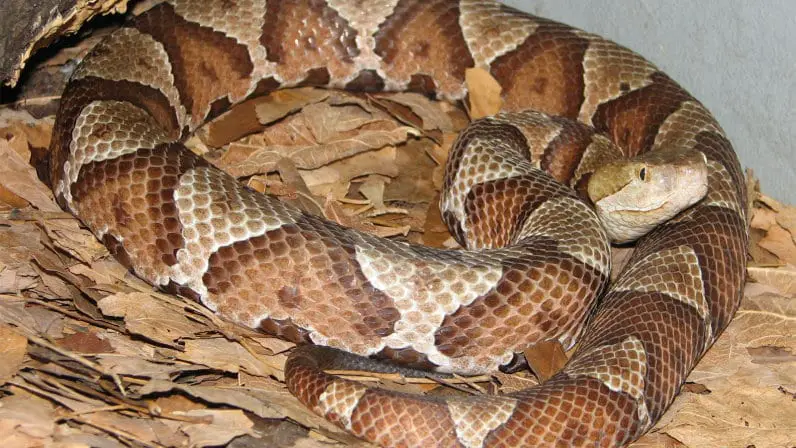
Agkistrodon contortrix is a venomous snake or a pit viper that is native to Eastern North America. The common name for this species is the copperhead. Five subspecies are recognized copperheads.
Adult snakes are 20 to 37 inches in length, with males larger than females. The largest recorded copperhead is 53 inches for the A. c. mokasen subspecies. The snake’s body is stout with a broad head that’s distinct from the neck.
The color of a copperhead can be pale tan to a pink tank and usually darkens towards the snake’s foreline with dark crossbands. Dark brown spots are found on the snake’s flanks along the belly. On the tail are three brown crossbands and a gray area.
In young snakes, the tail markings are more distinct with very visible crossbands and a yellow tip. On the snake’s head is an unmarked crown with a pair of tiny dark marks along the side of the head. Still, there are different patterns and color combinations found in different subspecies of copperheads.
Just like other pit vipers, the copperhead is an ambush predator. It can assume a position that will let it wait for its prey for a long time without being noticed. But when hunting insects, these will actively move to catch their prey.
Young snakes make use of their colorful tails to lure frogs and lizards. Species found in the Southern United States are nocturnal during the summer. This snake will prefer to avoid any contact with humans and will leave any confrontation without biting. But compared to other vipers, the copperhead will freeze then run away and this causes the snake to bite them.
It can be impossible to see a copperhead as it lies on dead leaves or clay soil. The snake will only strike when the person or animal is very close to it. It will also vibrate its tail in 40 times a second, which is faster compared to other non-rattlesnake species.
4) Rattlesnake
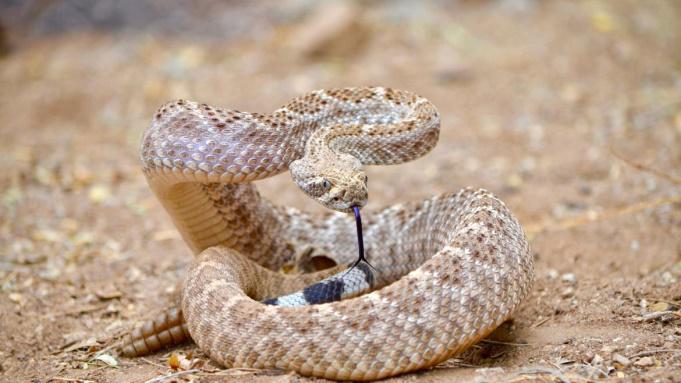
Rattlesnake refers to any of the 33 species of New World vipers that are venomous by nature. Rattlesnakes have a segmented rattle along the tip of their tails that create a buzzing sound when it is moved or vibrated. This viper is found in a wide area from southern parts of Canada to central Argentina. There are a diverse species of rattlesnakes from the southwestern United States and in parts of northern Mexico.
Adult rattlesnakes vary in length from 1.6 to 6.6 feet. A few species of rattlesnakes have marked with transverse patterns. However, some rattlesnakes come with dark patterns such as hexagons, diamonds, or rhombuses against a light background. Some snakes have a gray or light brown background while others have green, orange, pink or red.
The most common species of rattlesnakes native to North America are timber rattlesnakes, prairie rattlesnakes, and western diamondbacks. There are also 26 more species in the region, including the North American sidewinder, the North American massasauga, and the pygmy rattler.
Most people are afraid of rattlesnakes because these may strike at any time, but actually, these snakes are not aggressive and will only attack when provoked. Rattlesnakes are very shy and timid but these are venomous and dangerous when mishandled.
A rattlesnake bite is painful, and a snake that is more than a meter long may be fatal. The most lethal rattlesnakes are the Mexican west coast rattlesnake, Mojave rattlesnake, and the South American rattler. The venom of these snakes targets the nervous system more than other rattlesnake species. The South American rattlesnake is the most widely distributed as it is found from Mexico to a wide area in Argentina. This snake is seen all over Central and South America.
Rattlesnakes are known as pit vipers and have heat-sensing pits between their eyes and nostril, which helps them hunt for prey. These pits help the snake sense their prey using heat emitted by the prey. This unique characteristic allows the snake to strike their prey even in the night.
Rattlesnakes are nocturnal and are found in dry or arid environments. These animals hide during the day and only come out in the twilight hours to hunt. The fangs of a rattlesnake are similar to a hypodermic needle but with a curved shape. There are large venom glands located at the base of the jaws, and these are responsible for the head’s triangular shape.
A rattlesnake may lose its fangs due to wear and tear, but this is not a concern at all, with several developing fangs at the back of the primary fang. Rattlers can grow fangs up to 6 inches long. These are folded back when not in use or when the snake’s mouth is closed.
Rattlesnakes cannot bear extreme heat or very cold climates. When the day is very hot, these snakes hide in burrows or under large rocks. These may hide together in crevices during the winter as they hibernate. Some dens may have several snakes of different species.
5) Fer-de-lance
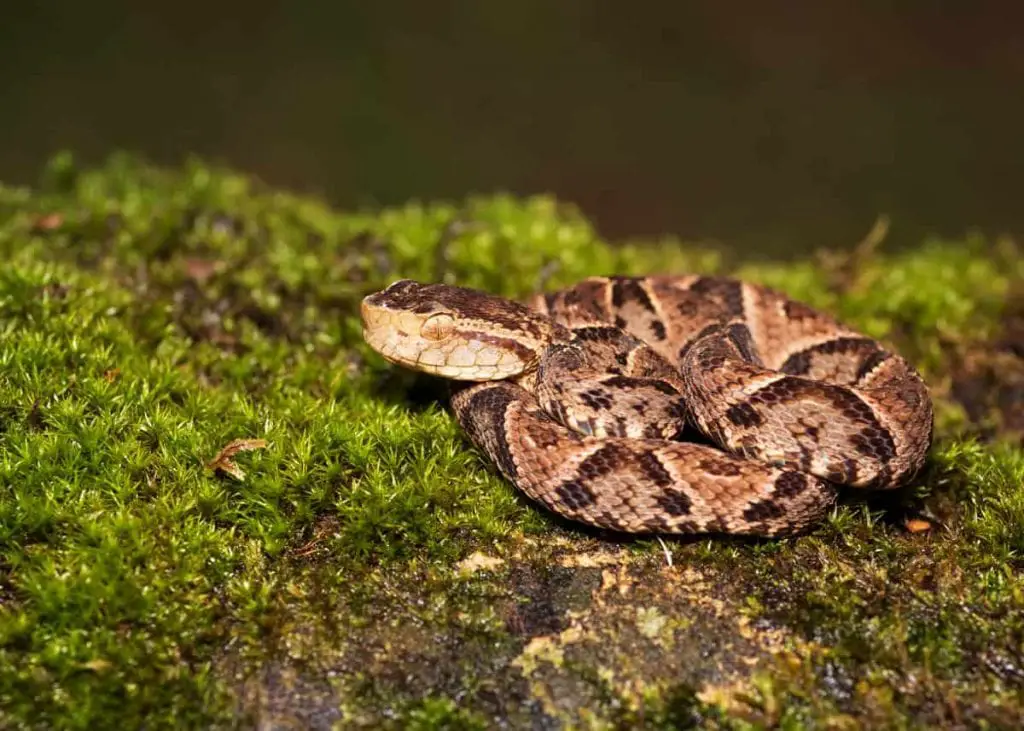
Fer-de-lance is a term for any extremely venomous snakes belonging to the viper family. These snakes are native to cultivated lands and forests in tropical America and tropical Asia. Fer-de-lance in Spain is the barba Amarilla or yellow chin. This is a pit viper with a sensory pit located between its eyes and nostrils. This pit viper has a broad head and grows up to 7 feet long. This is gray or brown with black diamond marks. The bite of a barba amarilla is fatal.
The name fer-de-lance is also used to describe snakes found in Central and South America with the genus Bothrops. Venomous snakes that belong to this genus are the habus, Wagler’s pit viper, jararaca, wutu or urutu, and jumping viper.
One of the largest and very aggressive snakes native to the Amami and Okinawa islands in the Ryukyu Islands is the Okinawa habu. This snake frequent human homes and has a length of 5 feet with bold dark-green marks. The venom of the Okinawa habu is not as potent as other vipers but can cause loss of limb or, in worst cases, death.
Meanwhile, the jararaca is native to Brazil, where it is usually found along with grassy areas. The bite of this snake causes death. The yarara in Argentina is dangerous with bold, thick, and dark semi-circles with yellow outlines.
The jumping viper has a brown-gray color. This is a Central American snake with diamond markings along its back. Its name was derived from its ability to jump from the ground. Its venom is not as lethal to humans.
6) Matilda’s horned viper (Atheris matildae)
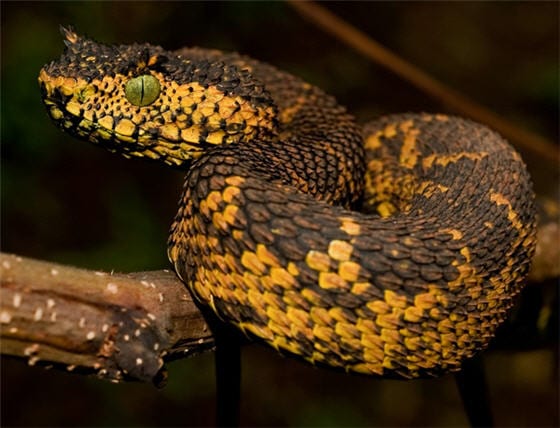
The Atheris matildae or Matilda’s horned viper is a species of vipers found in Tanzania. This viper was just recently discovered in 2010 during a biological survey of the Southern Highlands of Tanzania. The exact area where this viper was found was never revealed to avoid illegal trade. The discovery of Matilda’s horned viper was published at the Zootaxa journal where the authors mentioned that they had created a captive breeding colony for the snake species.
Matilda’s horned viper is a nocturnal snake and is an ambush predator. It will wait patiently in streams to ambush prey, such as frogs and lizards. This species only occupies a tiny region that is threatened by charcoal production and logging.
7) Namaqua dwarf adder (Bitis schneideri)
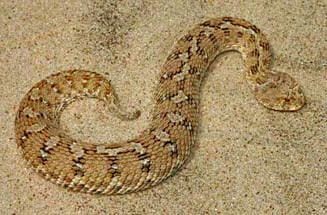
The Namaqua dwarf adder is a venomous viper located in a small coastal area between Namibia and South Africa. It is known as the smallest species of viper and has no known subspecies. The Namaqua dwarf adder can grow up to 10 inches only. It is the world’s smallest viperid.
The venom of the Namaqua dwarf adder is intense with the bite causing severe pain, extreme swelling, oozing, and discoloration coming from the punctures. The swelling and pain will gradually subside after several days and complete healing was reported in two weeks. There is no antivenom for the bite of a Namaqua dwarf adder.
8) Southern American bushmaster (Lachesis muta)
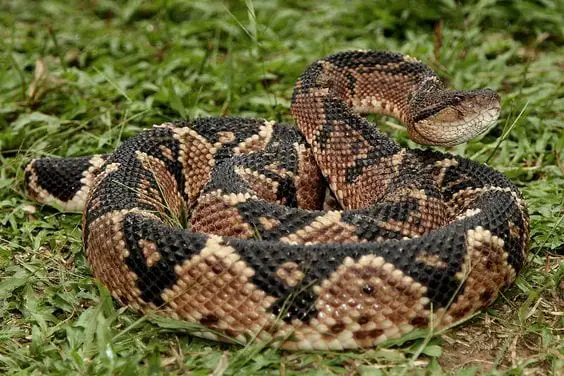
The Southern American bushmaster is a venomous viper native to South America, including Trinidad in the Republic of Trinidad and Tobago.
This is known as the largest viper and the longest venomous snake species that can be found in the western hemisphere. Adults are 10 feet and weigh up to 11 pounds. It has a broad head with a narrow neck. The body has a cylindrical shape with a tapered snout. Similar to most New World vipers, the tail of the Southern American bushmaster can vibrate in response to threats.
This snake has a yellow, reddish, or brown-gray color with dark brown or black marks that create lateral triangles. This can produce a large amount of venom but is weaker compared to other viper species. The Southern American bushmaster’s diet is made up of mice and rats.
Conclusion
These are among the most popular true viper species. Understanding and being familiar with the natural behaviors of these snakes will make you safer in case you find any of these species in the wild. And no matter what, don’t provoke a snake. Most snakes, especially vipers, are simply timid and would only attack when provoked or hurt.

